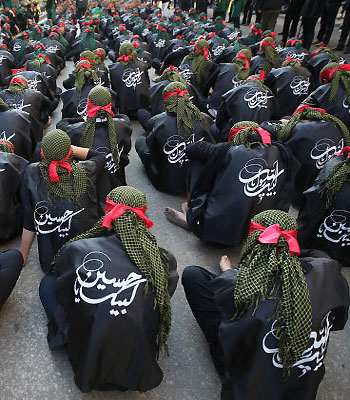Beirut-Latest studies issued by the Washington Institute for Near East Policy, titled “A Transformative Experience: Understanding Hezbollah’s Involvement in Syria,” confirmed that participating in the Syrian war has exhausted Hezbollah fighters and drained it.
The study mentioned noted that despite extensive reporting on Hezbollah’s involvement in Syria, little attention has been paid to the experience the militia has gained there or the consequences it faces back home in Lebanon.
The Hezbollah contingent in Syria (often referred to as “Hezbollah’s Eastern Command” by Israeli analysts) deploys between 5,000 and 8,000 fighters at any given time, including Special Forces (Katibat Radwan), standing forces from all units, part-time fighters (taabia), and new recruits who have undergone a fast-tracked combat training period of 60-90 days — an unprecedented development.
Still, Hezbollah fighters are not cannon fodder; they often lead battles and command Syrian and Iranian militias in combat.
This heavy involvement in Syria seems to be influencing the group’s overall approach to military planning and execution.
According to a study written by an Israel Defense Forces officer in 2014, Hezbollah would likely employ a more offensive fighting strategy in any future war against Israel, with the objective of shortening the conflict’s length.
Regardless of whether the group actually implements such a strategy, there is no doubt that some of its military capabilities have improved significantly.
It has learned how to use its drones more effectively, take better advantage of its short-range rockets, and execute complex offensive operations.
At the same time, the Syria war has decreased Hezbollah’s popularity among the Shiite community in Lebanon, particularly as financial constraints lead to cuts in salaries and social services.
In response, the group has framed the conflict as a war of necessity against Sunni extremism, with leader Hassan Nasrallah preying on widespread sectarian fears by issuing frequent reminders about the need to defend against ISIS and al-Qaeda affiliate Jabhat al-Nusra.
Furthermore, Hezbollah’s continued funding of its support base, combined with the lack of alternatives from state institutions or other organizations, has ensured continued public support despite the dip in popularity.
The study stresses that when Hezbollah began its involvement in Syria, its priorities, strategies, and narrative shifted. First, it devoted much more of its budget to military spending.
Despite that funding for social services continued, yet more of it was directed to families and institutions linked to Hezbollah’s military infrastructure, as part of an effort to support the troops.
As Hezbollah becomes more deeply entrenched in Syria, the resistance that once attracted eager volunteers has transformed into a corporate institution of anxious and exhausted fighters.
Far from answering a calling, recruits are now signing on for a job in the Syria war, spurred by the monthly salary of $500-1,200 with benefits.
According to the study, today, many so-called Hezbollah fighters have become disillusioned by the group’s role in the Syrian conflict, by the arrogance and military ineptitude of allied Iranian forces, and by the corruption and weakness of the Syrian army.
They also worry that Russia will sell them short if it serves Moscow’s interests in Syria — while Hezbollah is sending more fighters to Syria, Vladimir Putin is making agreements with Turkey and Israel.
Although the conflict has exhausted Hezbollah fighters, drained the Shiite community socially and financially, and deepened class differences, the sons of
senior Hezbollah officials are thriving — a phenomenon that has sparked feelings of disenfranchisement among many Lebanese Shiites.
Regarding Hezbollah’s future, three points are important to remember: the group will remain committed to fighting in Syria alongside Iran and the Assad regime, the war has solidified its position within the “axis of resistance,” and improvements in its capabilities will likely trickle down to other militias and terrorist organizations in the Middle East.
In other words, groups that received training from Hezbollah or monitored its tactics even before the Syria war — such as Shiite militias in Iraq, the Houthis in Yemen, and Palestinian organizations like Hamas and Islamic Jihad — will likely incorporate the organization’s new tactics into their own operations in the coming years.
